CHECK OUT OUR PROJECT MAGAZINE OF THE FIRST PROJECT YEAR:
.............................................................................................................................
MATHEMATICS CLUB ACTIVITIES
I CHECKERS

Short description: During the game children will learn to play checkers, follow the game by the rules. Children will teach eachother the rules and tell the difference of up and down, right and left.
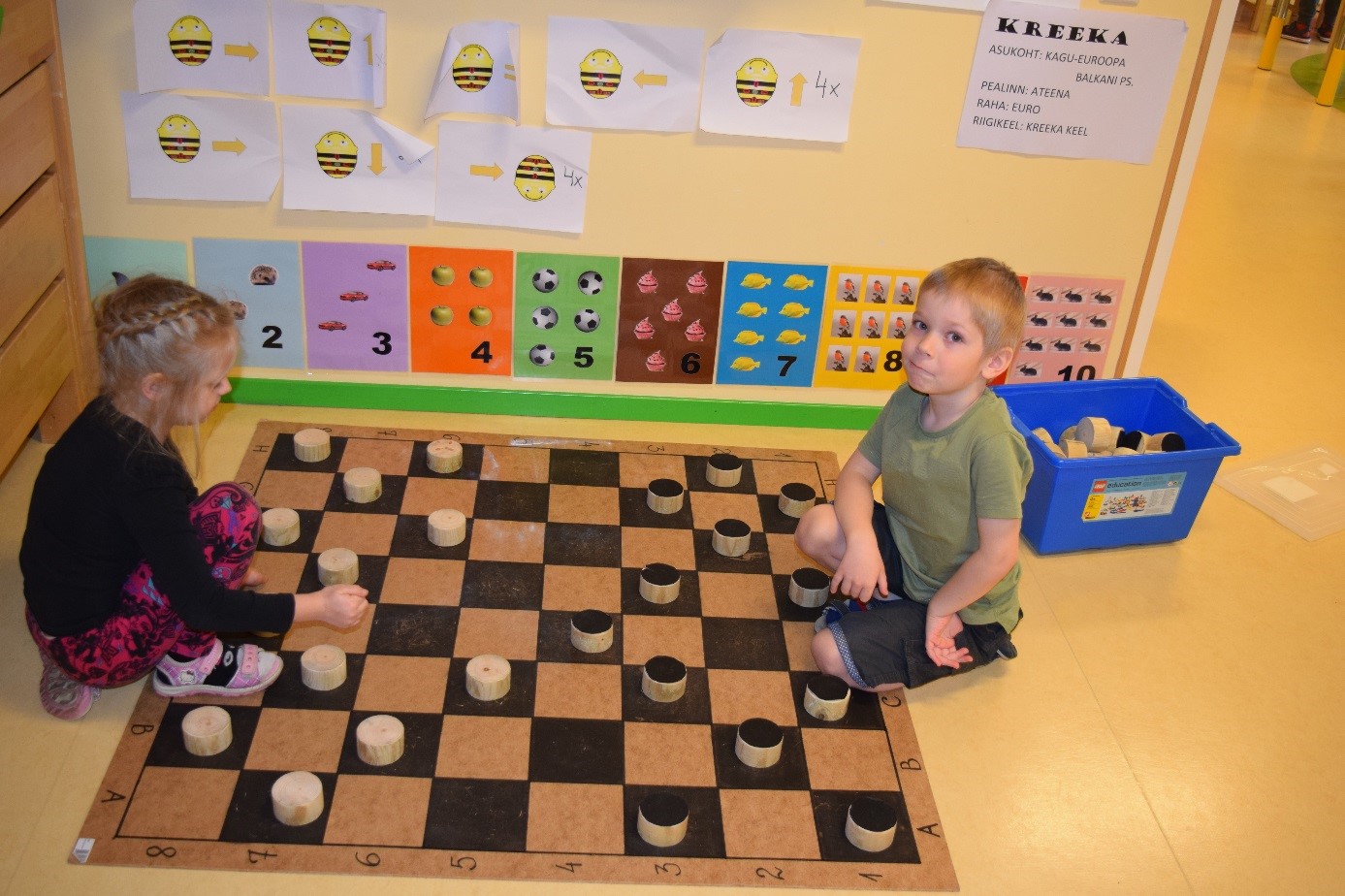
Name of the class: Õnneseened Age of the children: 4-5 years
Teachers: Kätrin Pukk and Laura Lisanna Saidla
Purpouse of the activitie: To learn what is and how to play checkers
- The child focuses on the activitie for 20 minutes
- The child follows rules of the game and explanes them to ohter children if needed.
- The child assorts the items by the distinctive features.
- The child knows the right and left
- The child knows the concept of up and down
- The children will be caring towards the ohter players and they understand the consequences of their behaviour toward others.
- The child understands the necessaty of recycling and environmental protection, is caring towards the environment.
Tools: Checkers board with checkers
Tools to build the checkers: ruler, waterproof markers, leftover wooden pillars, black and white paper, wood fiber board of desired size
Detailed description of the activitie:
Before learning to play checkers the children built checkers boards with their teachers. The grid of the game should be drawn on the board, and checkers nobs should be cut out from the wooden pillars. The children can help with writing the numbers, coloring the board and gluing the round shaped papers in the direct colors on the nobs. Our team decided to make life sized boards out of wood, so the game could be played on the ground (indoor or outdoor).
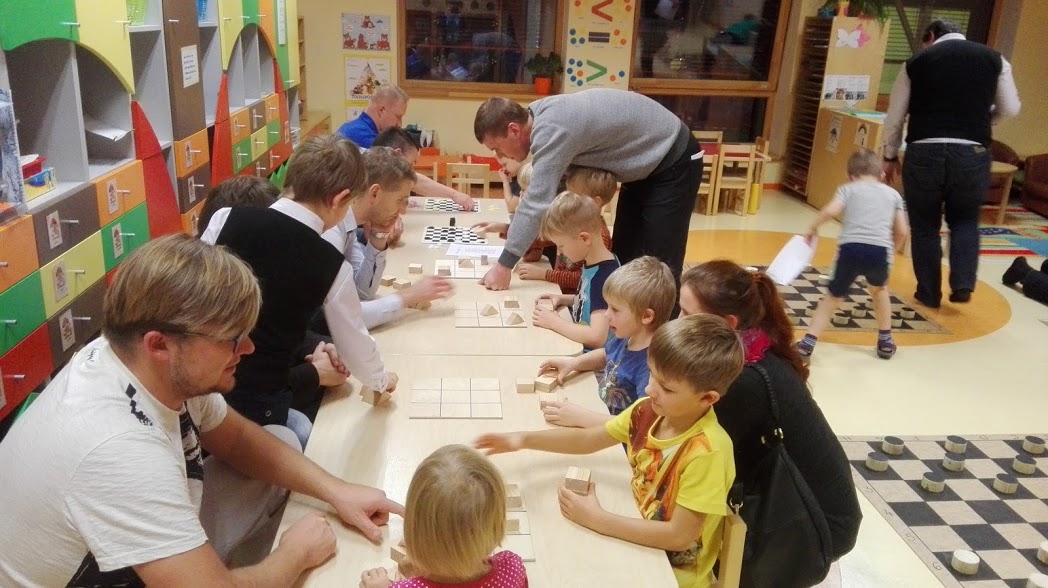
Learning to play:
What is the checkers? Checker is a mind-game or a competition where two partners (parties) compete. Partner in the game can be only one person or a multiplayer team.
Checkers in known from Europe to Asia. In Estonia the most well knows are International checkers and Russian checkers. Estonian championships in international checkers are held since 1955 and Russian checkers since 1949.
The game requires a chess board and 12 nobs for each player. To start the game, the buttons are placed in 3rd row on each side of the starting position, but only in the black fields. Throughout the game, the buttons move on black squares. One player starts and then moves in turn. Each time it is mandatory to complete the gear. The button can be moved only diagonally and only one step at a time, and this square can not be reached with the button already in place. The only exception to this is to knock over the opponent's jump.
If an opponent's button is in the diagonal next to its button and an empty box is behind it, the player can jump over the opponent's button with which it is knocked out and removed from the game. From the new place, you can jump and jump over the buttons and hit the opponent's knobs as long as possible. The game ends when one of the players can no longer move with any buttons or all of his buttons are beaten. In both cases, he has lost the game. It's useful to protect the button so that you always have your own buttons behind them. Then it's not possible to jump over them. It is good to beguile or force the other player so that you can jump over them in the next move. It's especially good if you can jump over several buttons at the same gear.
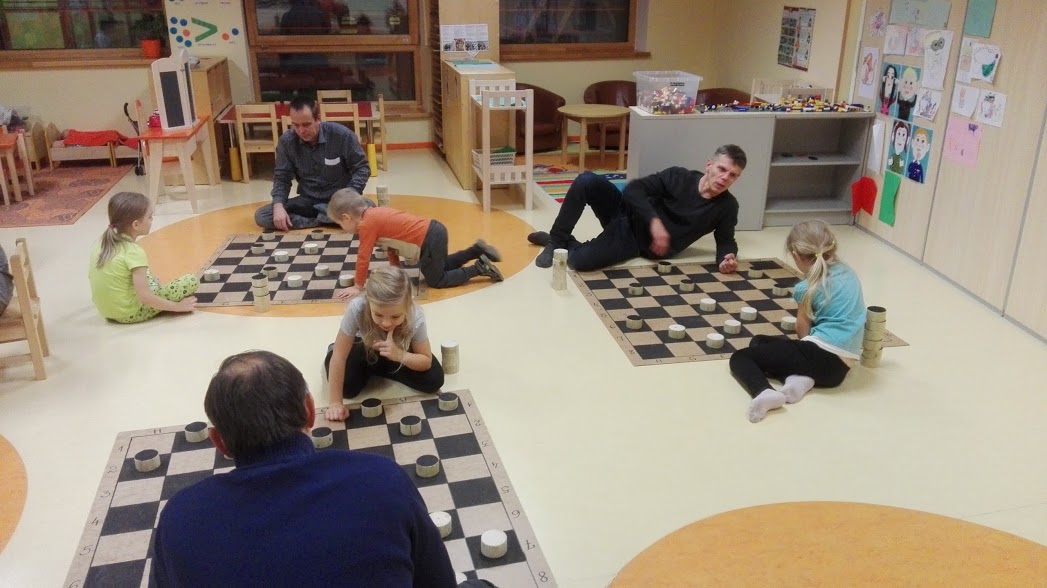
In our class we asked all the parents to join in the game during fathers day. During fathers day all the classes had workshops, so all of our 135 families had the chance to leran to play checkers with their children and also in teams. Also during our Valentines day cafeteria the families had the chance to join in.
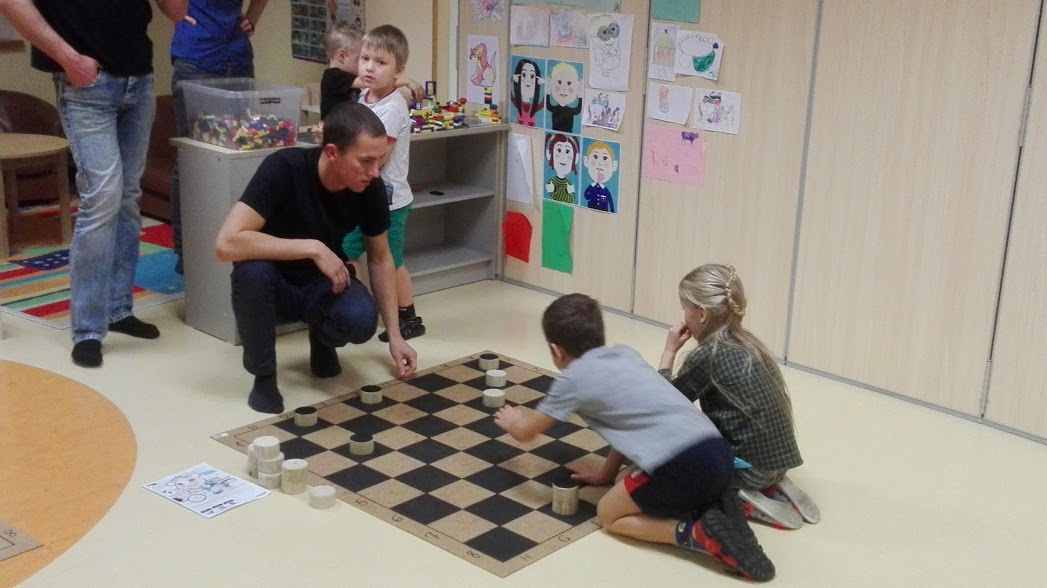
-------------------------------------------------------------------------------------------------------------
II JOYFUL COLORS
Short description: In this activitie the children learn about colores, expressing the feeling of joy and how to paint with their bodies in a group activitie.

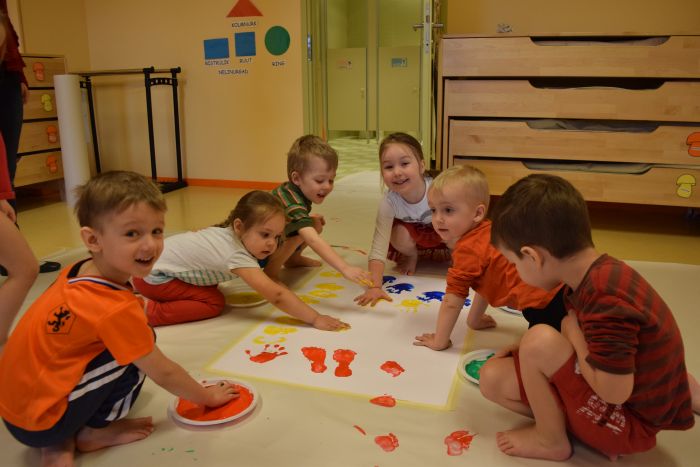
Name of the class: Õnneseened Age of the children: 4-5 years
Teachers: Kätrin Pukk and Laura Lisanna Saidla
Purpouse of the activitie:
- The child can express joy.
- The child enjoy belonging to a group, company of their peer group and joint activities.
- The child co-operates, shares and exchanges tools to achieve the goal.
- The child act creatively, using their knowledge and skills.
- The child can express him/herself.
- The child remembers a poem by his/her heart.
- The child know the meaning of joy.
- The child names colors yellow, blue, green, pink, red.
- The child can apply color to the material by the means chosen by him.
- The child prints with his whole arm and leg.
- The child enjoys participating in art activities.
- The child finds blue, yellow, red and green in the surrounding with the teachers guidance.
Tools: gouache colors, exhange clothes, A1 paper, brushes, cardboard plates, good mood J
Detailed description of the activitie:
The theme of the week was "Joyful Colors". With the colors, the teacher and the children could discuss "What is joy?" During the week, we learned poetry and the children chose five colors they would like to discuss/leran about. These were - green, yellow, red, pink and blue. In this regard, we let the children dress daily according to color. Every day a diferent colore was in focuse.
In making the artwork, we divided the children into two groups. In choosing an art activitie the main focus was for the children to be activiely engaged in the painting by using their feet and hands. Each child chose the color he/her liked the most and painted it on the big paper according how he/she wanted – with hands, feet, brushes etc. Through this activity, children expressed their positive emotions.
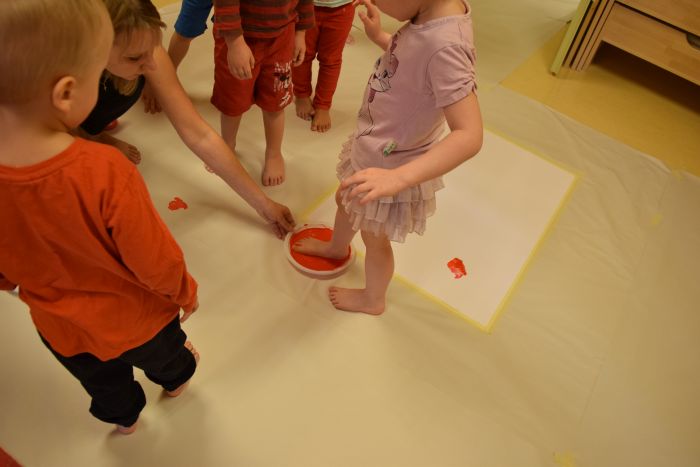
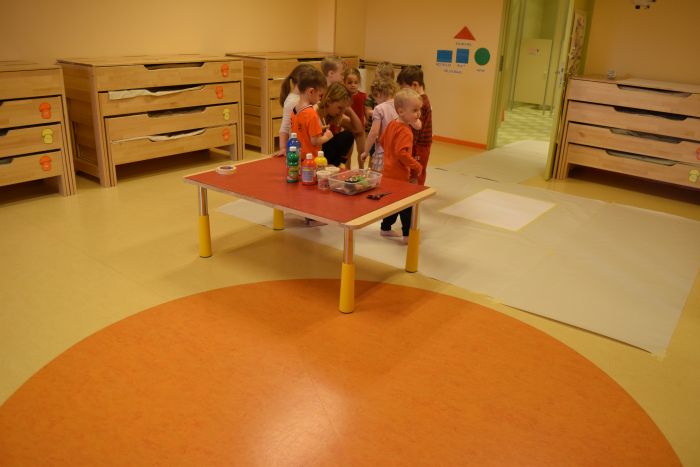
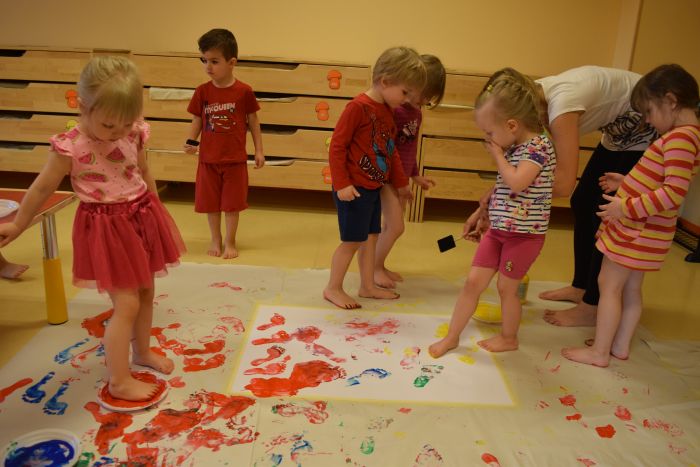
In the activity the children where able to express joy thru painting in a way they like the most. The only thing they needed to concider was ohter childrens artwork and not destroying the painting made by others.
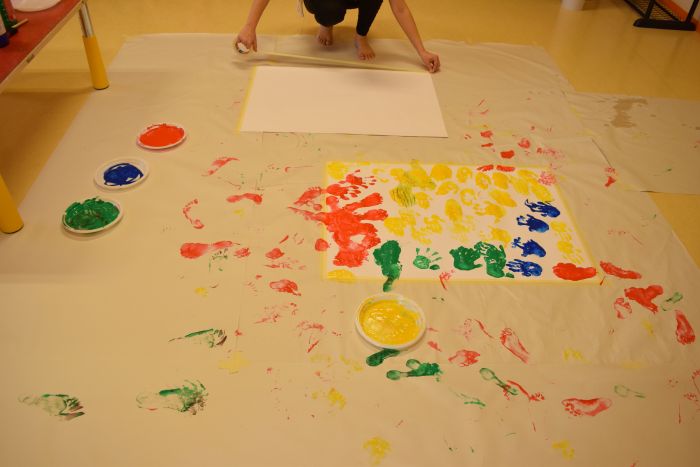
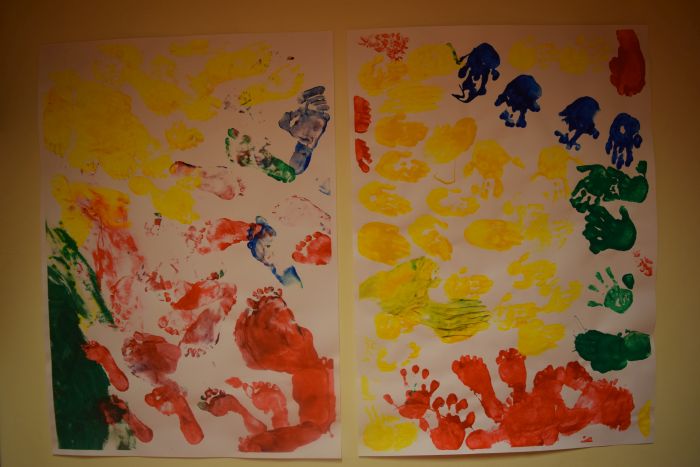
Poem „Ball of happiness“ with movements
I AM A BALL OF COLORES (child squats and shows the shape of a ball with hands)
A COLORFUL BALL OF HAPPINESS (standing up, pointing with the index finger, draws a happy face)
I SIT AND JUMP (child sits and jumps from achair)
AND ALSO SING (says it standing up)
THATS HOW I GROW UP TO BE BIG (lifts hands up above the head)
-----------------------------------------------------------------------------------------------------------
III SHAPE BINGO
Short description: During this game the children learn and repeat colors and geometrical shapes thru a bingo-styled activite

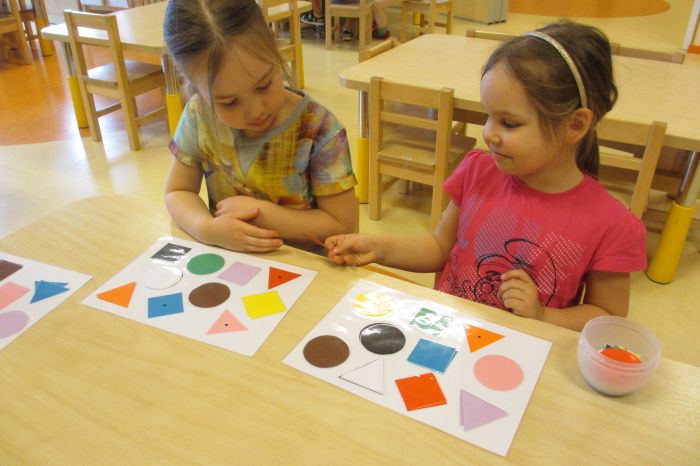
Name of the class: Õnneseened Age of the children: 4-5 years
Teachers: Kätrin Pukk and Laura Lisanna Saidla
Purpouse of the activitie:
- The child is able to watch and notice details, essential features and make logical connections.
- The children work together to achieve the goal
- The child is able to focus on the game.
- The child spells 3-4 syllable words correctly.
- The child tells the names of the geometrical shapes
- The child knows the shapes: circle, triangle, quadrangle
Tools: bingo boards, geometrical shapes
Detailed description of the activitie:
The main rule is everybody to work together, so the goal can be achieved.
To play the game a group of seven children was formed. Out of the seven children one of them is the leader and the other are the players. 6 bingo boards where shared between children.
The leader of the game starts to take different geometrical shapes and tells the co-players the name of the shape, and also the color of the shape. Players who has found all the shapes and placed them on the board will yell BINGO – he/she is the winner.
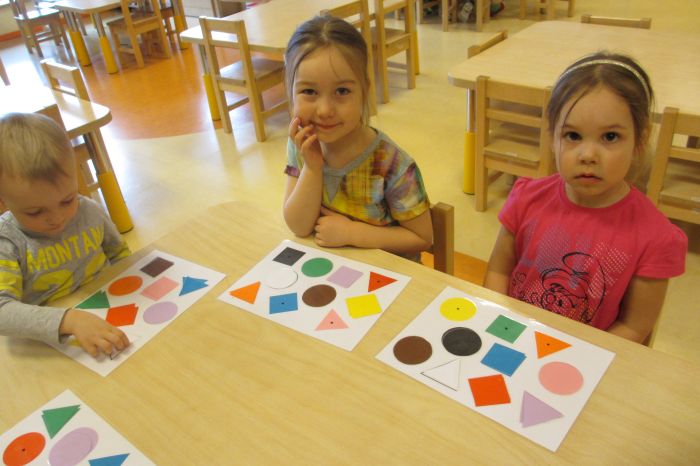
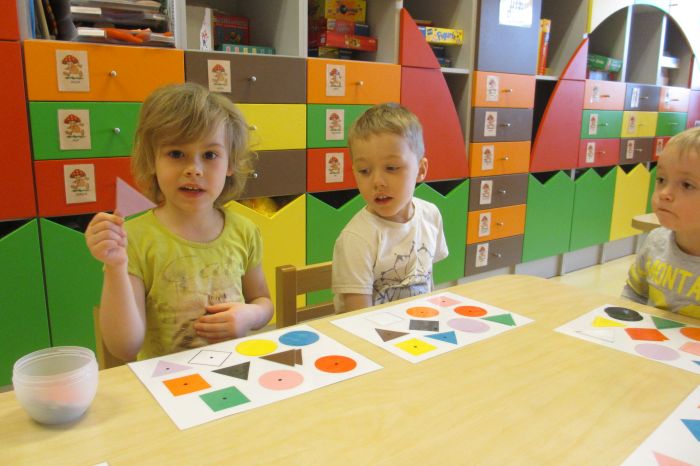
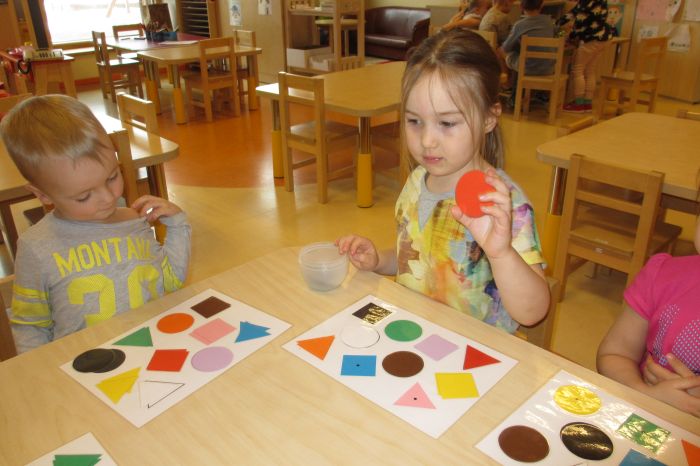
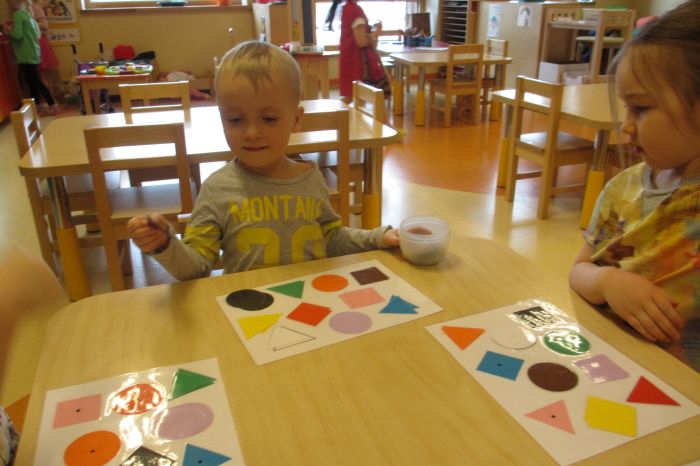
----------------------------------------------------------------------------------------------------------------
IV CREATE YOUR OWN LEGO STORY
Short description: In this activitie the visited Mektory School of Technology, wich offers public courses to all children and students. The children used LEGO StoryStarter kits to learn about mathematics and make up creative stories.

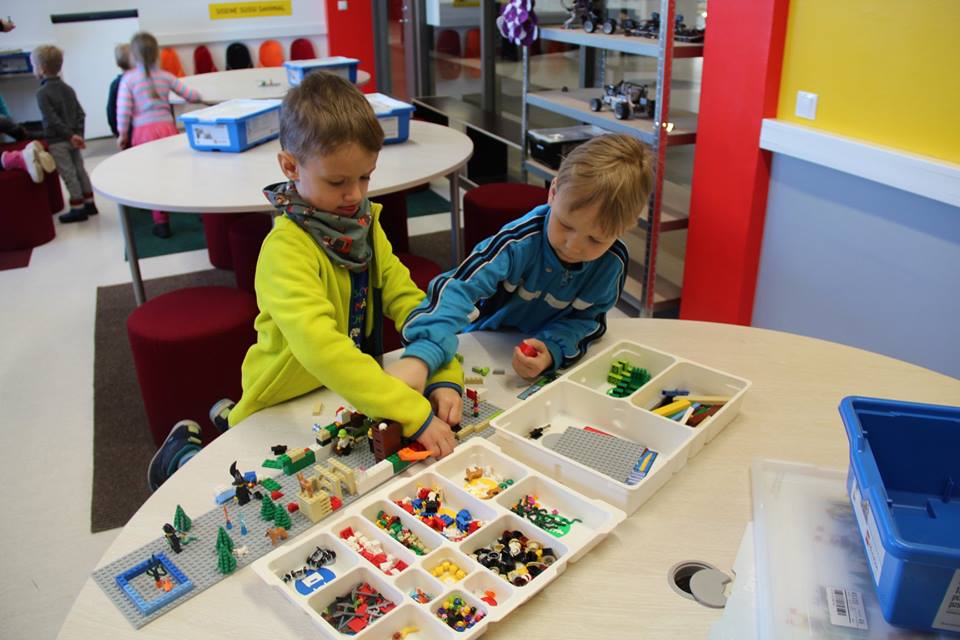
Name of the class: Õnneseened Age of the children: 4-5 years
Teachers: Kätrin Pukk and Laura Lisanna Saidla
Purpouse of the activitie:
The purpose of the educational tool is to develop students' spoken language, reading and writing skills. Students' self-confidence in self-expression and communication with others develops through the character-writing skills and story-thinking skills. The children will learn also about problem solving, accuracy, modeling with geometrical shapes and continuity
Each teaching task supports a specific topic in the language and literature curriculum, but depending on the model being built, it is possible to add tasks to other subjects: mathematics, nature, environment, etc.
Tools: LEGO StoryStarter kit
Detailed description of the activitie:
Children visited Mektory School of Technology to use LEGO StoryStarter learning kits which are used to teach about mathematics (logical thinking, constructing etc), language, speech and literature.
Learn more about using LEGO blocks to teach mathematics: https://education.lego.com/en-us/preschool/intro and https://education.lego.com/en-us/elementary/explore/language-arts
Choose a fairy tale with the children. The fairy tale can be self-designed or modernised actual fairy tale.
The story begins with the first sentence of the fairy tale and develops from there. Make sure that the scenes reflect the important stages of the story. If the children are old enough use the StoryVisualizer software to add text to the stories.
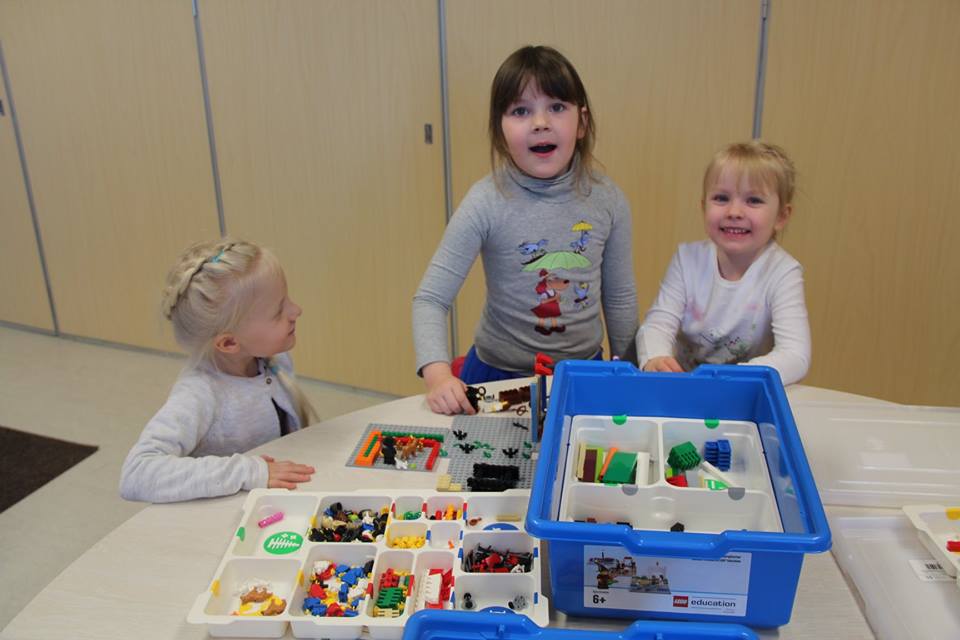
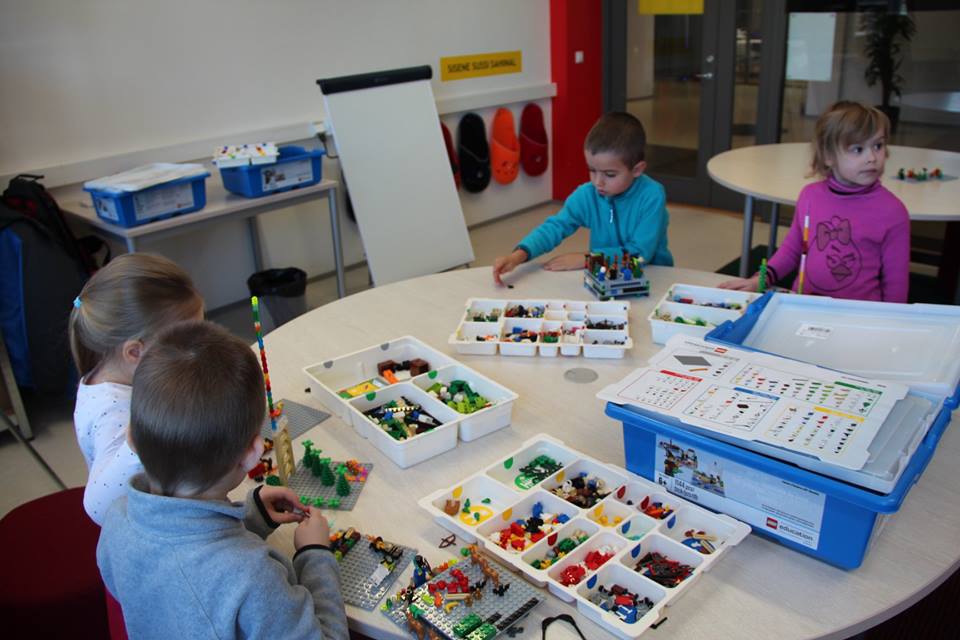 ---------------------------------------------------------------------------------------------------
---------------------------------------------------------------------------------------------------
V FEEL THE NUMBERS

Short description: In this game the children needed to guess thru touching what (wich number) is hidden under the blanket
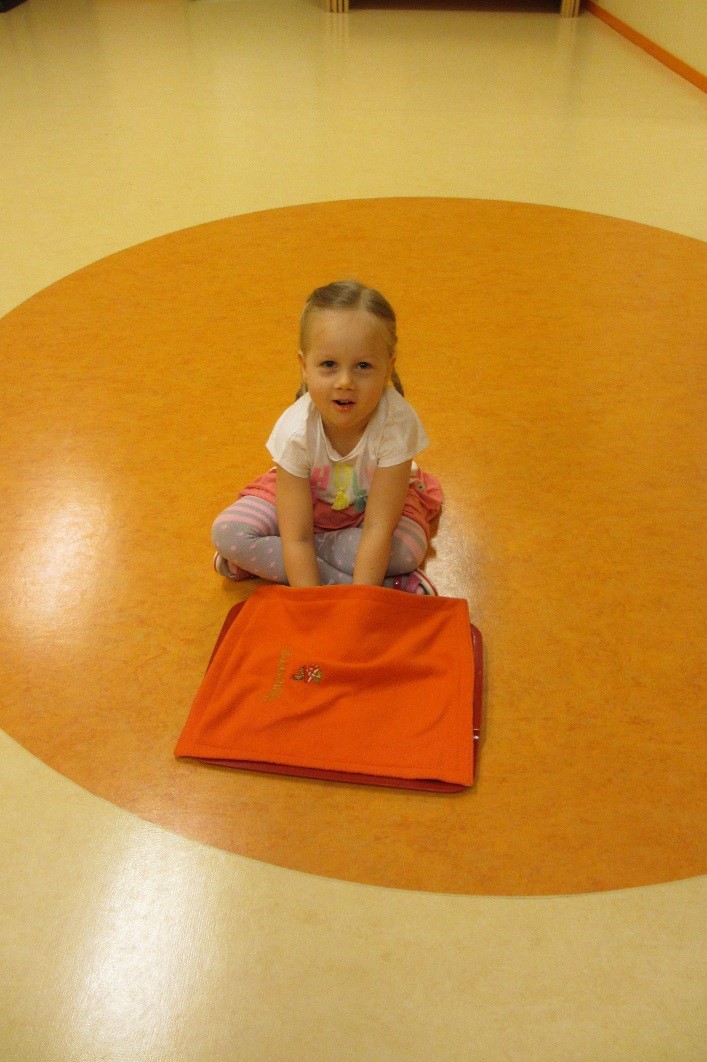
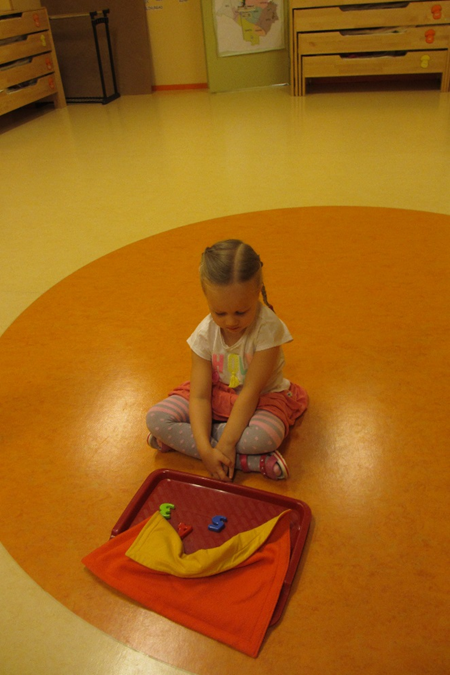
Name of the class: Õnneseened Age of the children: 4-5 years
Teachers: Kätrin Pukk and Laura Lisanna Saidla
Purpouse of the activitie:
- The child studied different numbers thru touching.
- The childs eye and hand coordination improves.
Tools: tray, colored numbers, blanket
Detailed description of the activitie: Before the game begun the children did not know what was hidden under the blankett. Each child came and sat next to the tray, put her/his hands under the blanket and tryed to guess what is hidden under without looking. Each child had to guess the number they where touching.
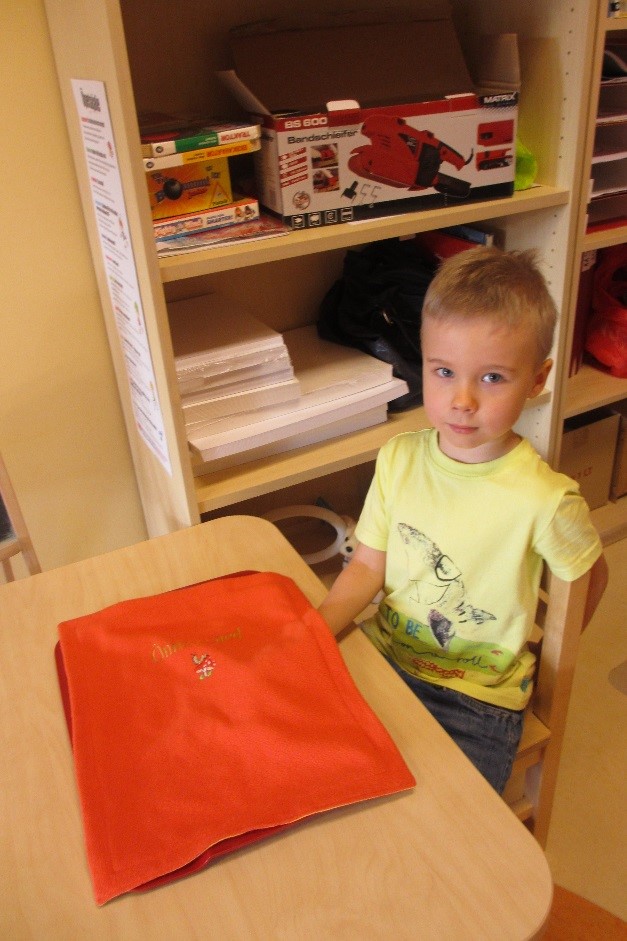
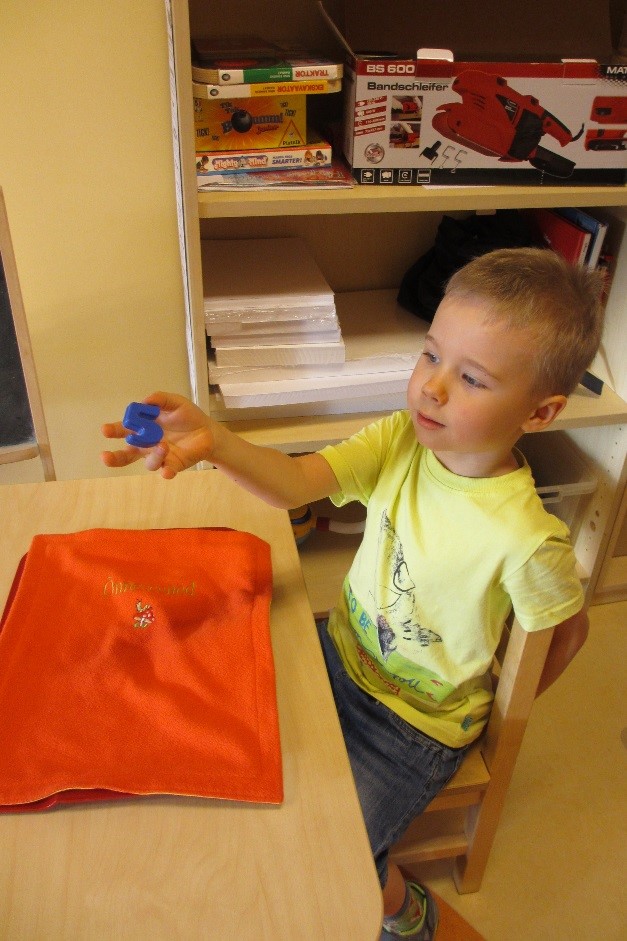
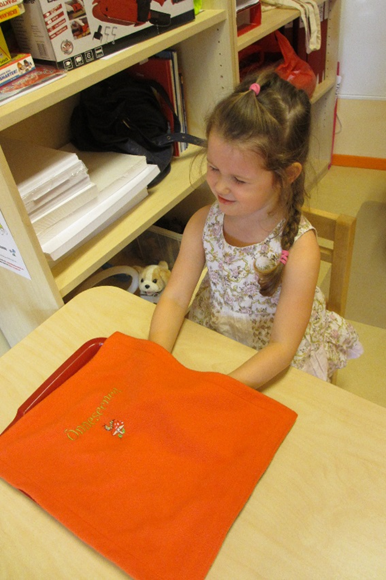
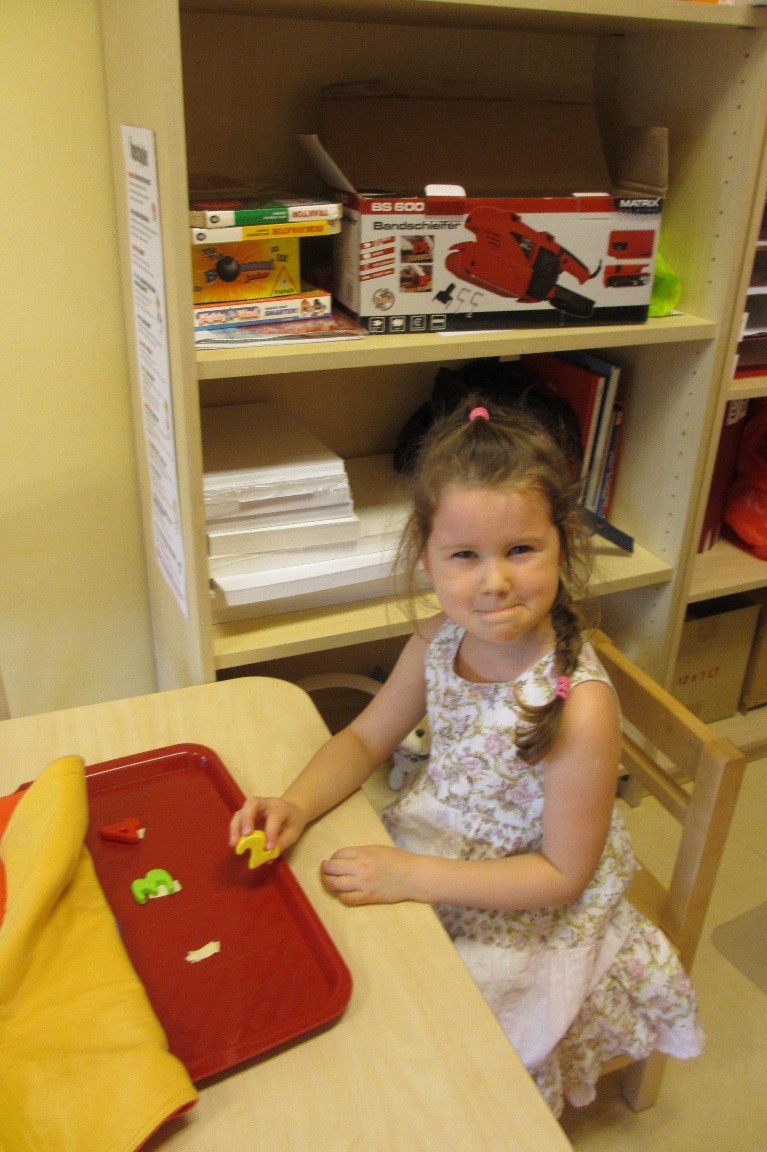
--------------------------------------------------------------------------------------
VI ROPE NUMBERS

Short description: In this activitie the child can learn about numbers in a creative way, thru movement and play.
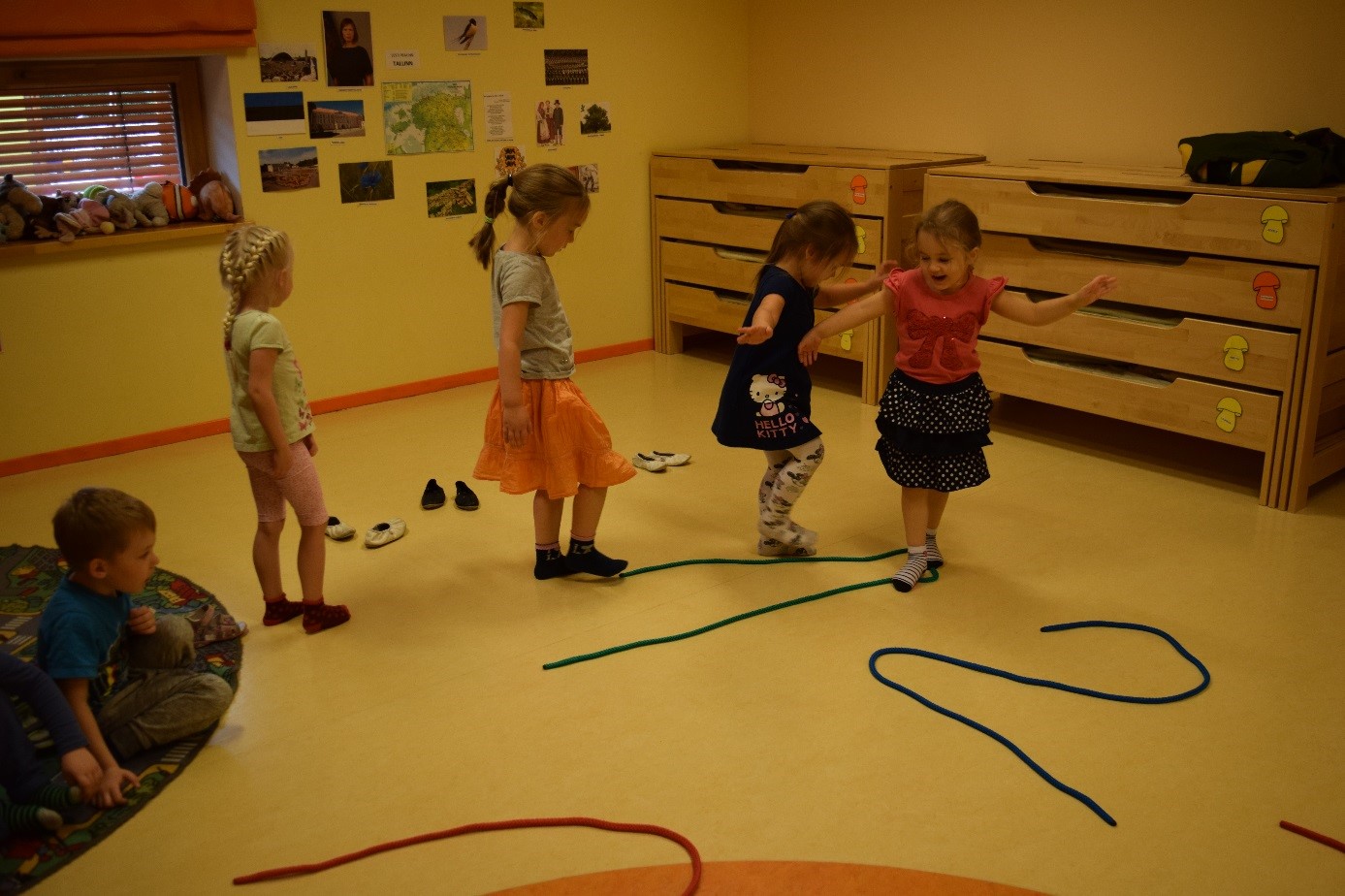
Name of the class: Õnneseened Age of the children: 4-5 years
Teachers: Kätrin Pukk and Laura Lisanna Saidla
Purpouse of the activitie:
- The child can hold his/her balance
- The child learns numbers through physical activity
Tools: colorful ropes or jumping ropes (made into numbers from 1 until 4)
Detailed description of the activitie: In this activitie the child can learn about numbers in a creative way, thru movement and play.
The teacher placed child sized rope numbers from 1 to 4 on the floor. At the same time, she also explaines the children what she is doing.
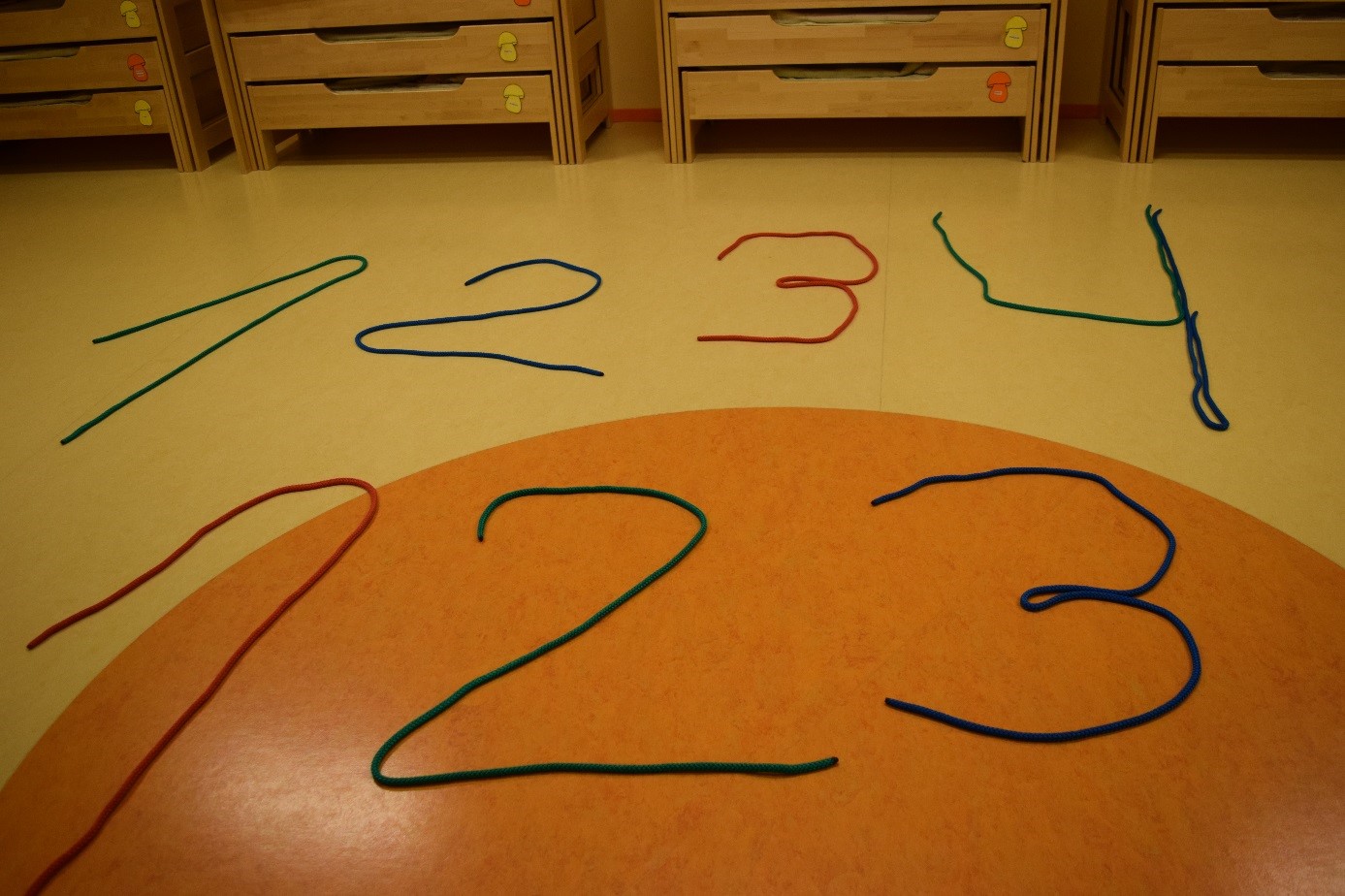
Then, the teacher shows to the children how to balance in the rope, by putting one foot infront of the other and keeping the arms upwards. Then, how to the child, which teaches the children about numbers through physical balance along the number. This is a good balance and coordination exercise for learning numbers thru movement.
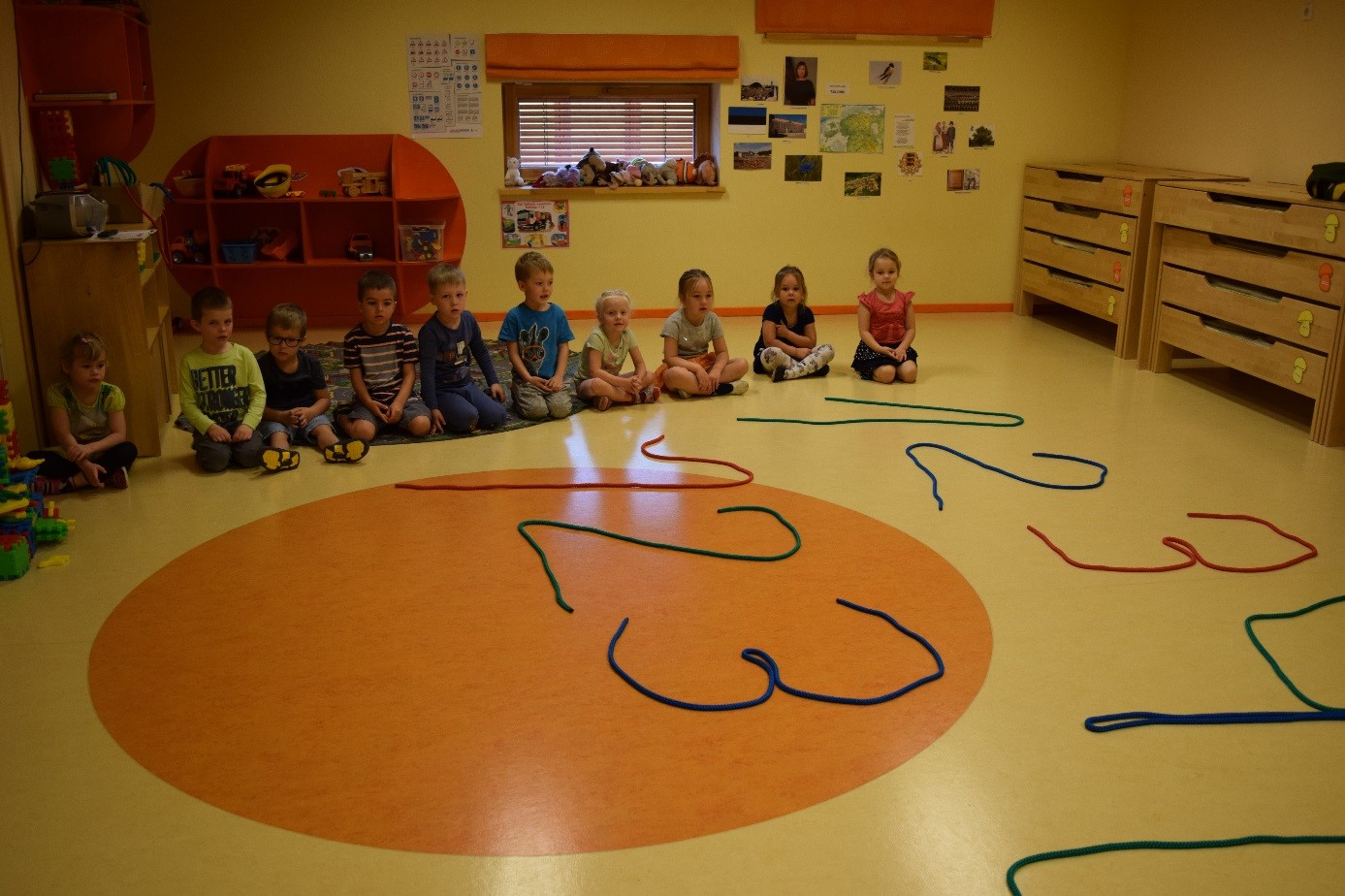
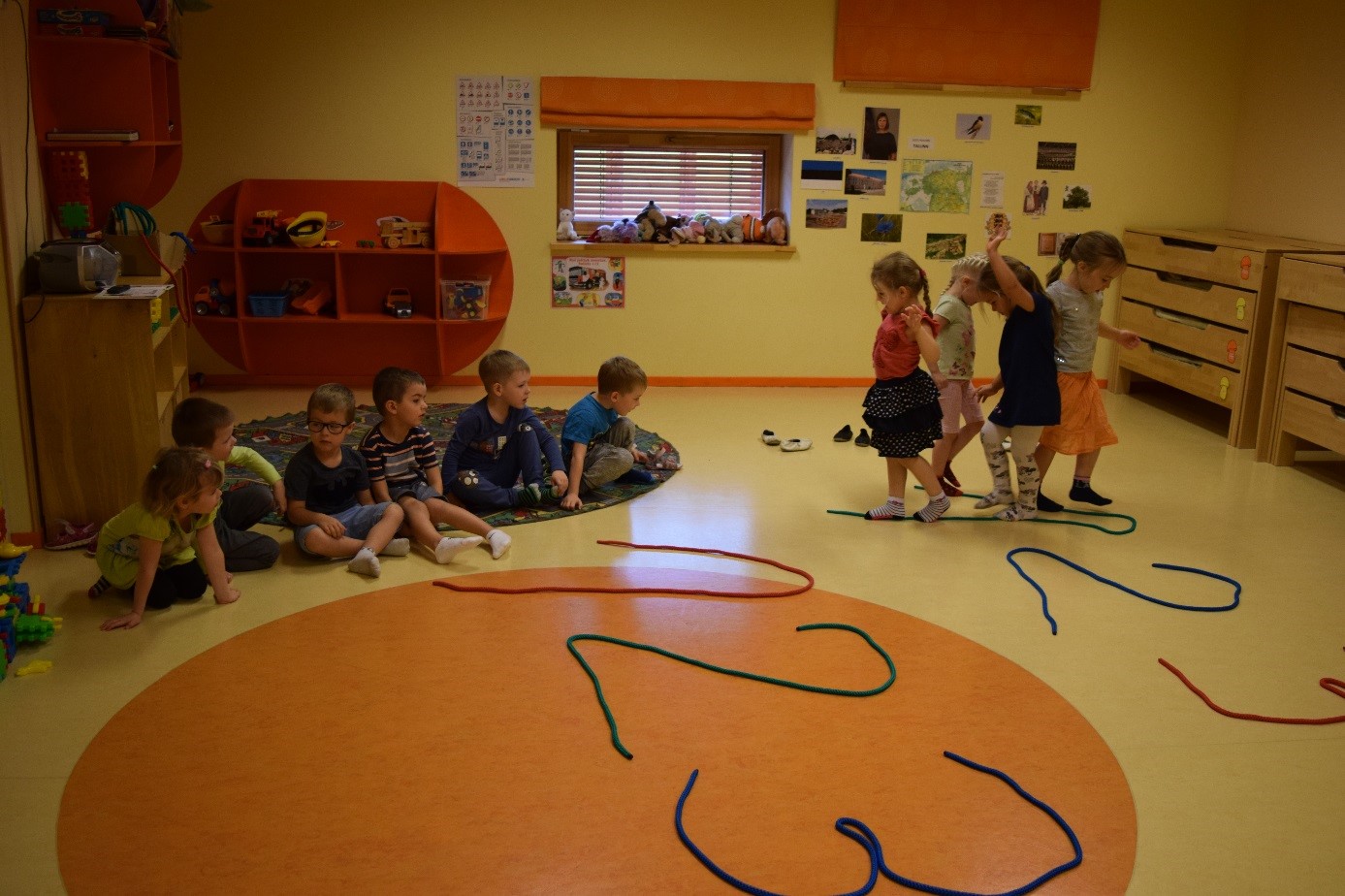
Later, the children received colored ropes and they tryed writing rope numbers themselves.
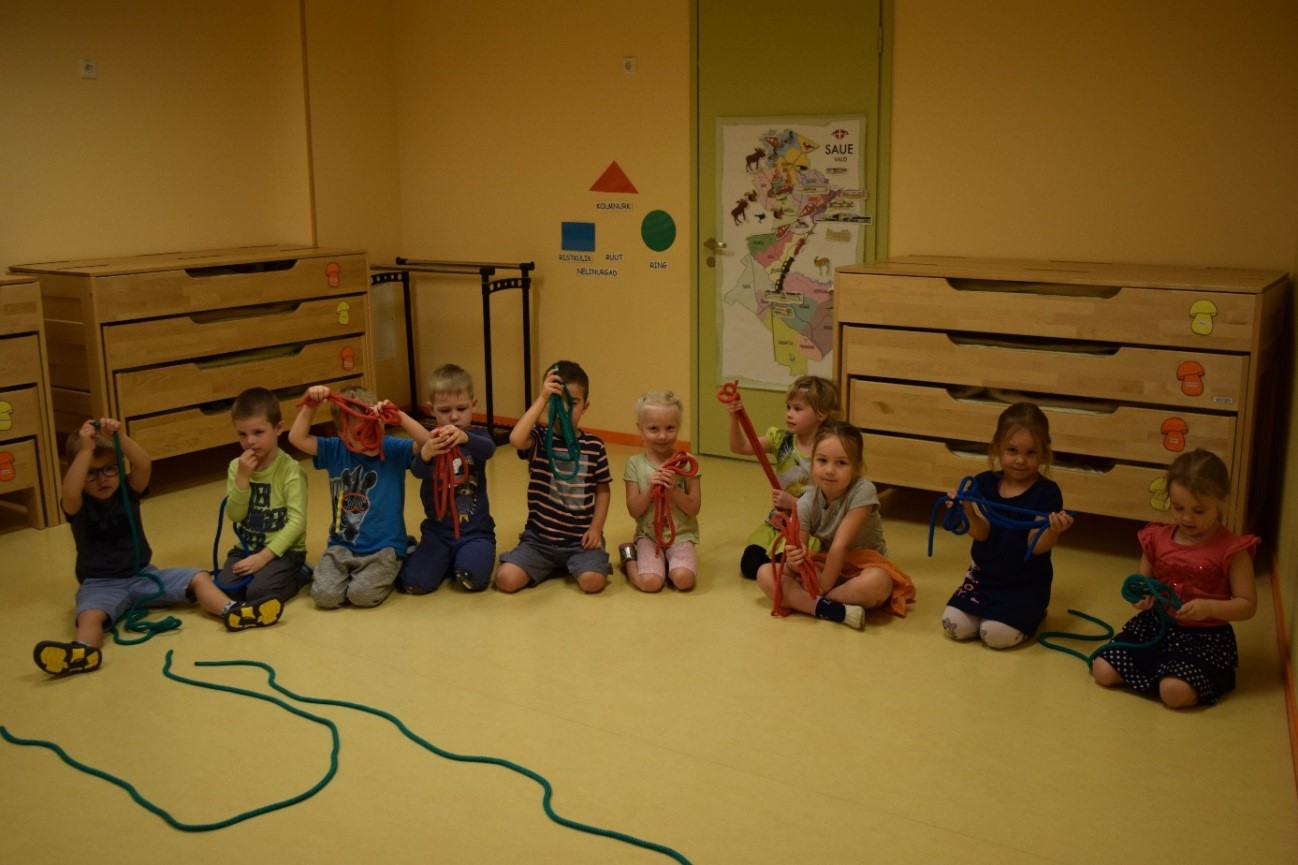
------------------------------------------------------------------------------------------------
VII FIND THE CORRECT GEOMETRICAL SHAPE

Short description: All the children learn about the geometrical shapes (how they look like) and use creative movement to find their way to the shapes on the room.
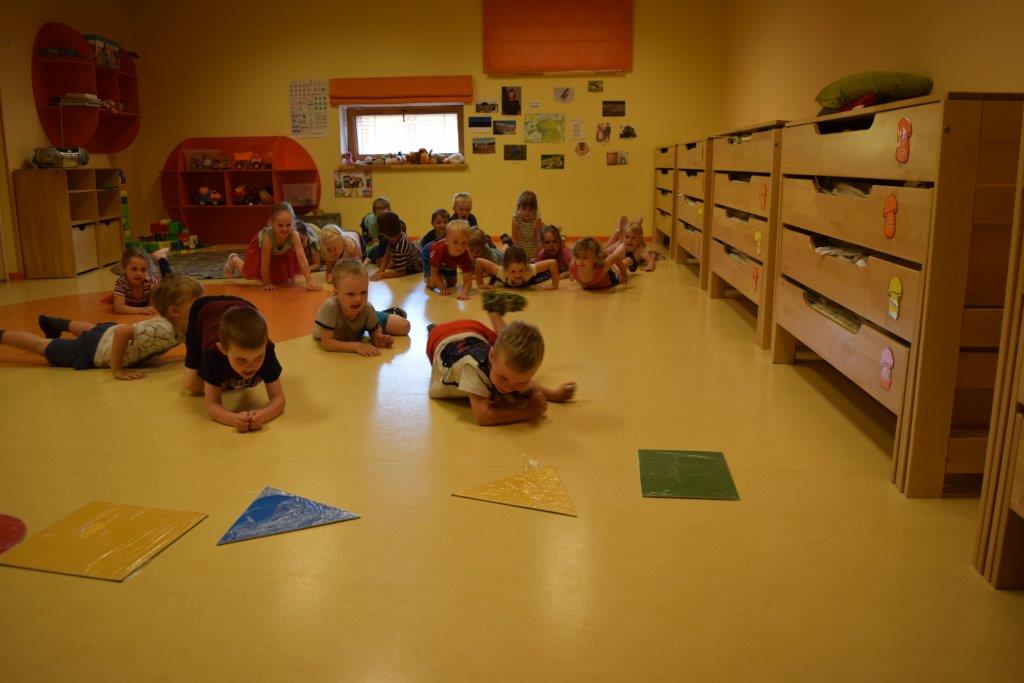
Name of the class: Õnneseened Age of the children: 4-5 years
Teachers: Kätrin Pukk and Laura Lisanna Saidla
Purpouse of the activitie:
- The child learns of geometric shapes
Tools: Large card shapes - square, rectangle, triangle, circle. Each image is in two sizes - large and small and in two colors. Eg: a small yellow square and a large red square.
Detailed description of the activitie:
The teacher places all shapes in a row on the floor, slightly further then she/he and the children are.
Teacher gives orders to the children:
• Walk high as a giraffe to a large red triangle
• Run fast as a cheetah to a small blue circle
• Rome as a crocodile to a small yellow square
• Swim as a fish to a small green rectangle.
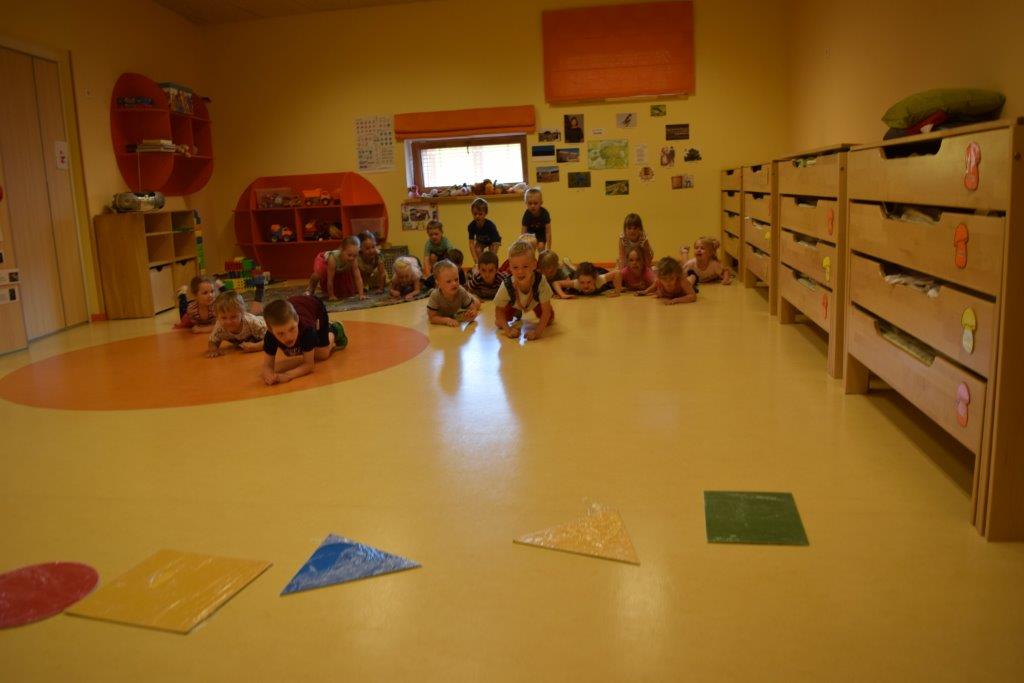
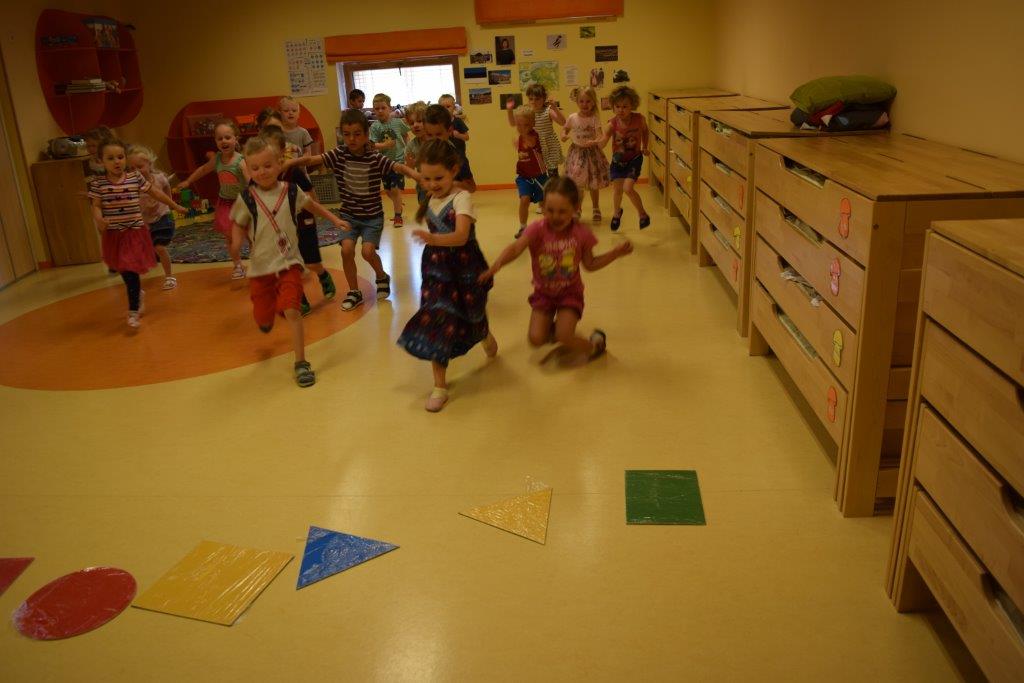
Rules:
- Each child must listen carefully to what the teacher asks and completes the orders.
- When the children know how to play, they can give directions themselves to ohter children and move in a specific way to find a geometrical shape.
------------------------------------------------------------------------------------------------------------------------
VIII TRAFFIC SIGNS

Short description: In this sorting activitie the children collect the traffic signs used together and sort them into groups (circles, squares, rectangles, triangles).
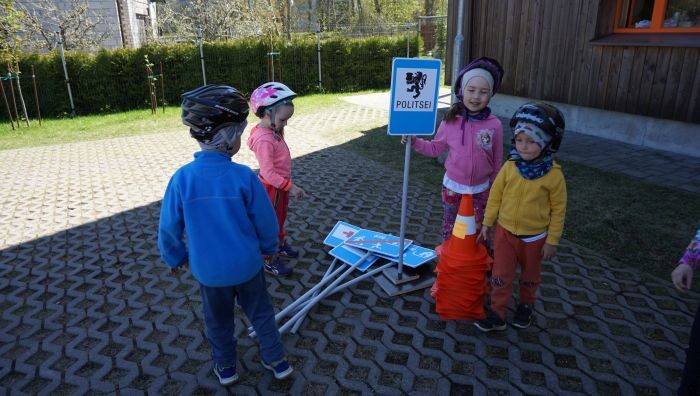
Name of the class: Õnneseened Age of the children: 4-5 years
Teachers: Kätrin Pukk and Laura Lisanna Saidla
Purpouse of the activitie:
- Child knows the geometrical shapes: square, rectangle, triangle, circle and can sort same shapes together in a group.
- Child knows traffic signs and their meaning
Tools: (Play) traffic signs
Detailed description of the activitie:
In this sorting activitie the children collect the traffic signs used together and sort them into groups.
Rules:
In the game the children firstly use the space provided to practice bycicle ryding. But it is important to follow the rules that are given on the traffic signs. The child follows the rules agreed at the beginning of the game (for example, if the child violates the traffic rules, he or she will go to the „police“-station - that is a police sign - and do five squats, and then he/she may go back on the track. Also it is important to move in one direction not to have accidents, etc.).
After riding with the bycicles the teacher askes all the children to find one sign and sort the signs into same type of groups. All the circled signes in one pile, squares in another pile etc. Later on the children check together if all the signs are put correcty.
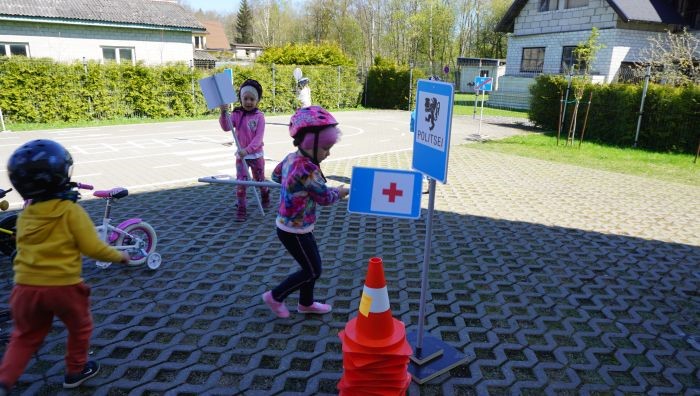

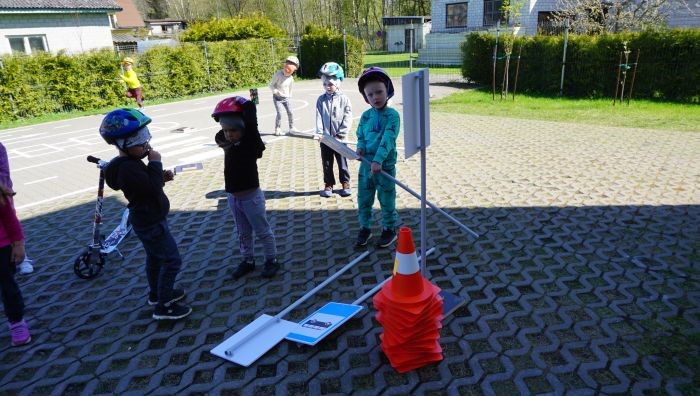
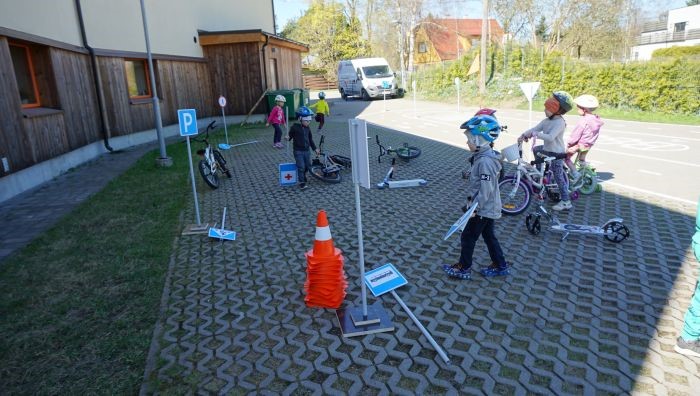
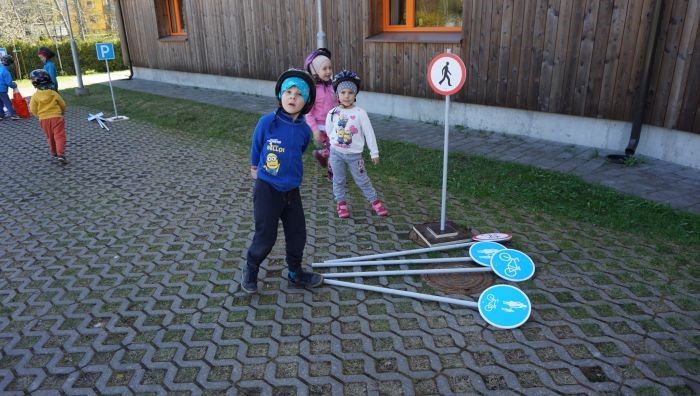
-----------------------------------------------------------------------------------------------------
IX OUTDOOR ORIENTEERING WITH SHAPES
Short description: In this activitie the children need to orienteer on the playground and find the hidden geometrical shapes. Later on the children make either mathematical equations using materials from the nature or decorate their geometrical shapes.
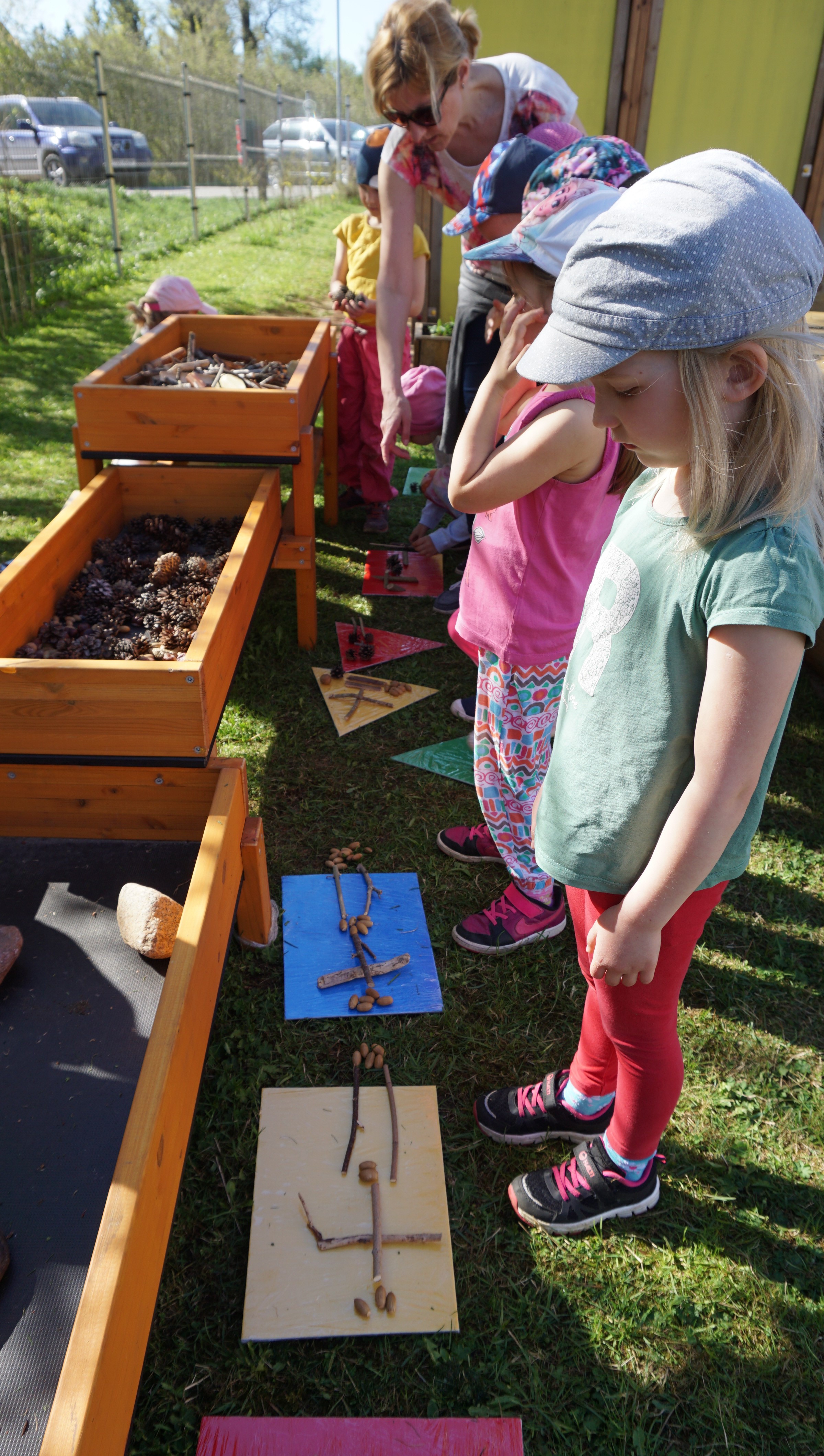
Name of the class: all the 6 classes of Nõlvaku Kindergarten
Age of the children: 3-7 years
Teachers: Kätrin Pukk
Purpouse of the activitie:
- The child sorts objects into groups on the basis of one or two attributes and compares the amount of objects in the groups.
- The child understands the counting activity and how numbers in a row are formed.
- The child knows geometric shapes: circle, triangle, square, rectangle
- The child distinguishes geometric shapes and can describe their similarities and differences.
- The child counts to 12
- The child uses natural material to perform mathematical equations and shapes and to decorate a geometric shape.
- The child knows basic colors: yellow, red, blue, green
- The child uses different materials in a creative way.
Tools: Geometric shapes, small cards with diferent colored geometric shapes, natural material: rocks, cones, acorns, branches etc.
Detailed description of the activitie:
This activitie was part of our kindergartens outdoor learning day, wich means all the age-groups took part in the activitie.
Before the activitie begins a teacher or a child can hide geometrical shapes all around the outdoor area. Later on the ohter children need to find the correct shapes.
The children are gathered around. The children discuss with the teachers what kind of geometrical shapes are found around them and how to recognise the shapes – how many corner does a triangel have, how many sides does a square have, how many corners does a circle have etc. The teacher explanes the children rules of the game.
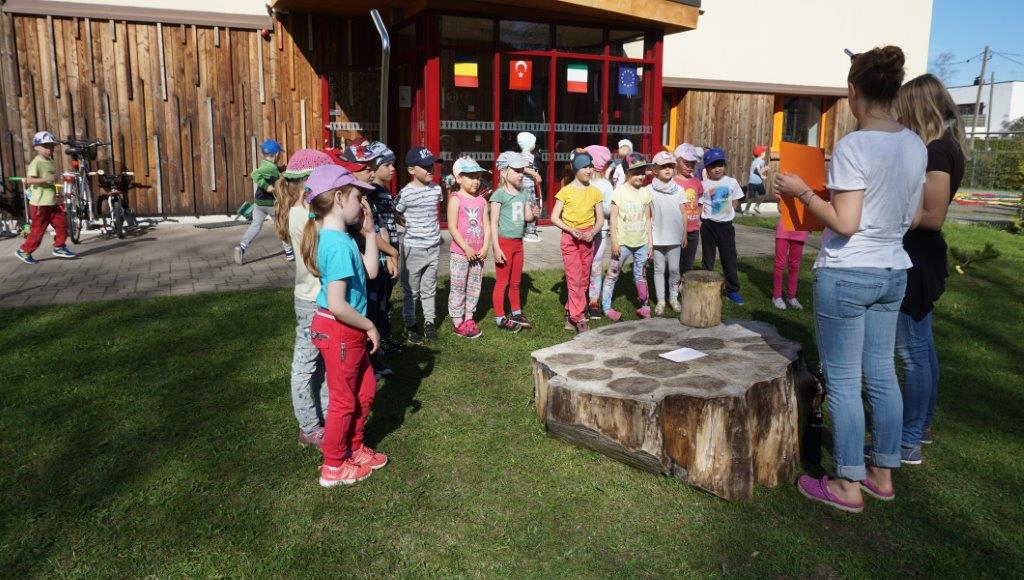
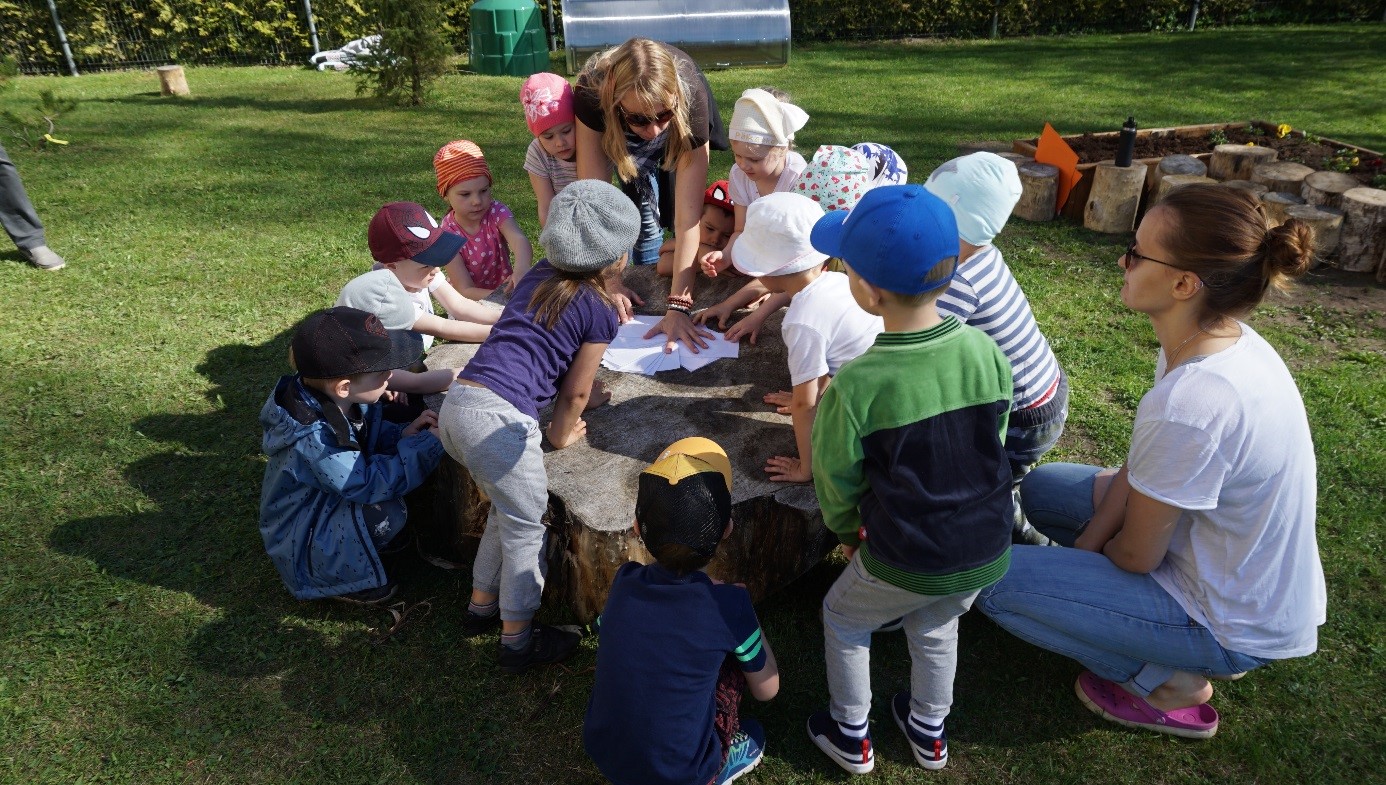
The children pick a random card (the cards are placed Picture down, so the child cant see the card he/she chooses). All the children need to go and find their geometrical shape from the yard/park that is show on their card. All the children have diferent shapes on their cards. When a child finds the shape with the correct shape and color, he/she will pick it up, bring it and the teacher and/or ohter child will check if the found shape is the correct one. The small picture card will be given back to the teacher.
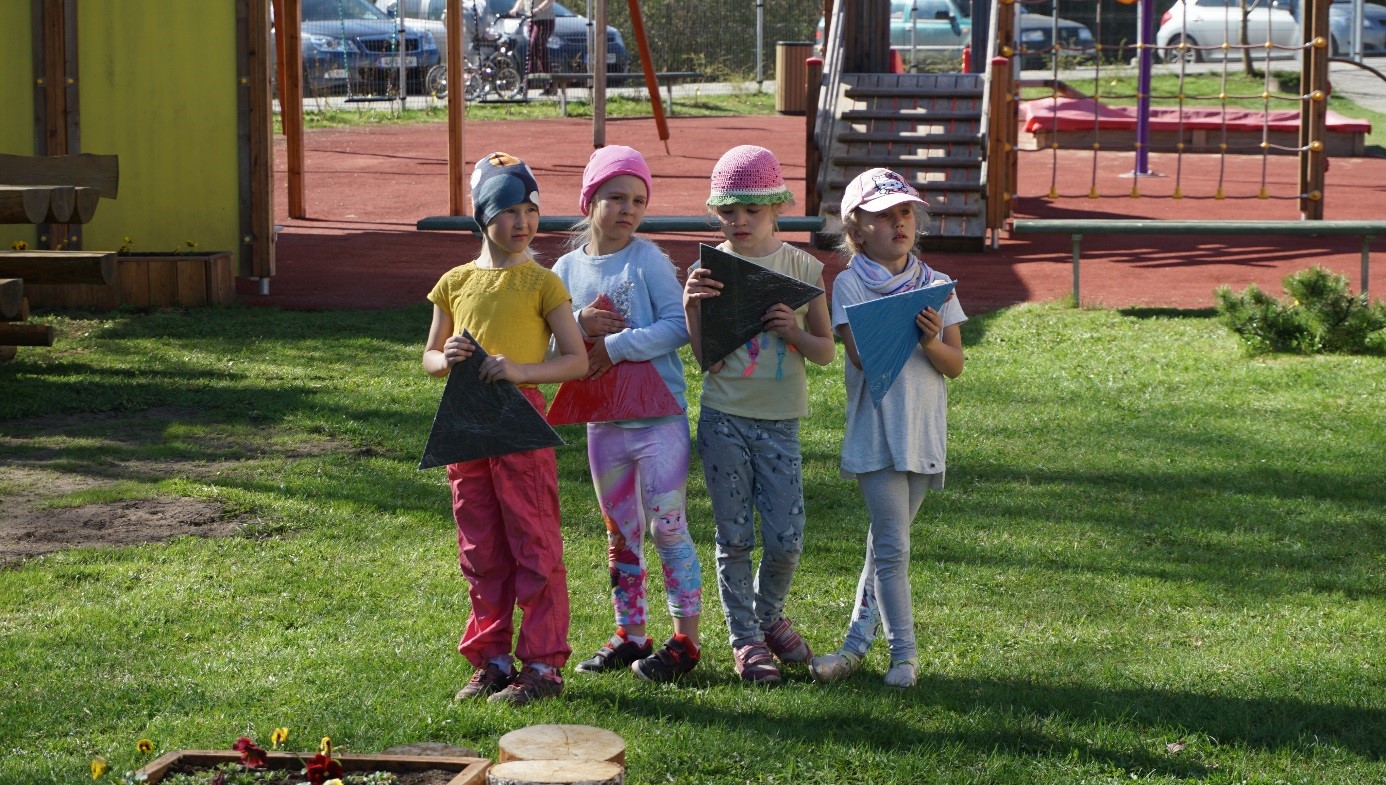
When all the children have found their shape the the children with the same shape need to find eachother and form groups of „circles“, „triangles“, „squares“ and „rectangles“.
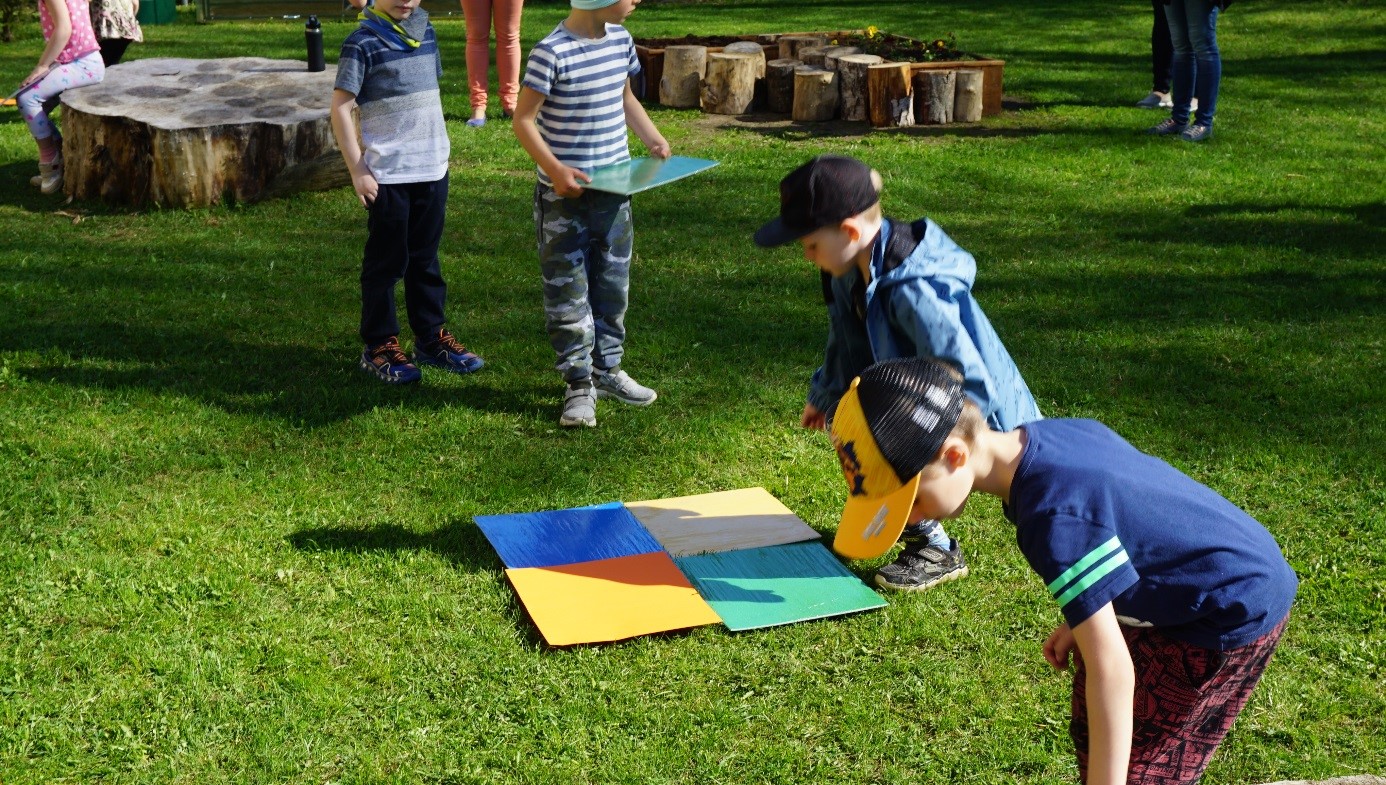
Then the children move together there, where the natural materials are placed in the yard. In Nõlvaku Kindergarten we have a are for outdoor play, where the material is held.
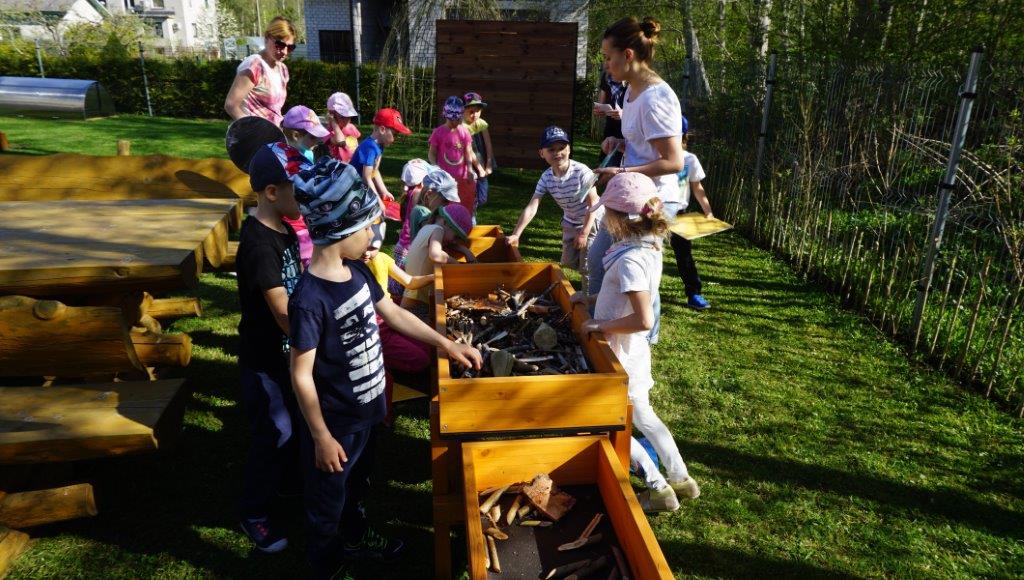
The 3-5 year old children decorated their shapes with natural materials how they liked. When they decorated the shapes the children counted for example how many acorns or rocks they used on their project and compared their numbers to the numbers of others, to determine whos number is bigger or smaller.
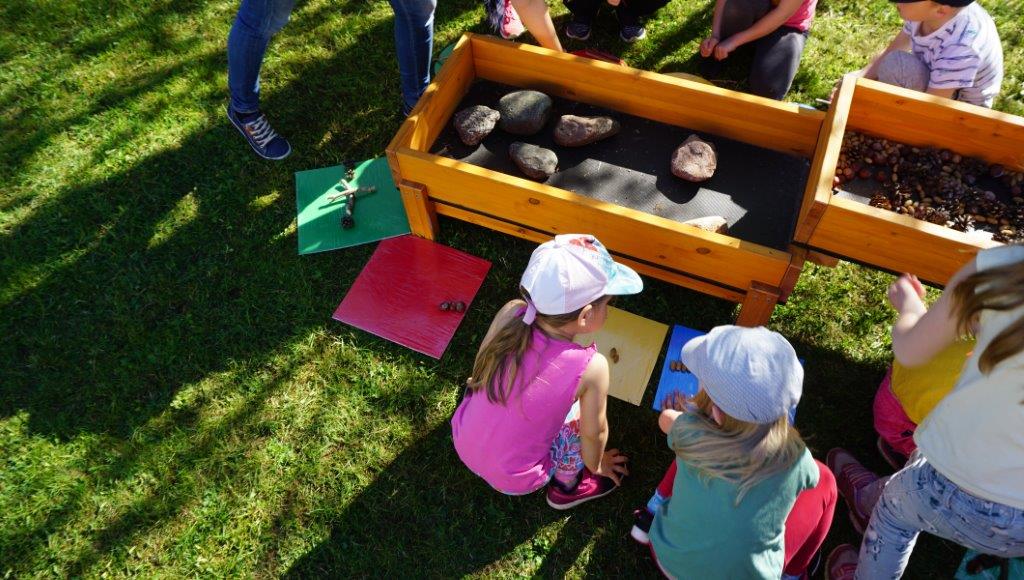
6-7 year old children fomed mathematical equations on their shapes. For example - how much is 5 rocks plus 10 rocks? When the equation was ready the children found a friend who solved it.
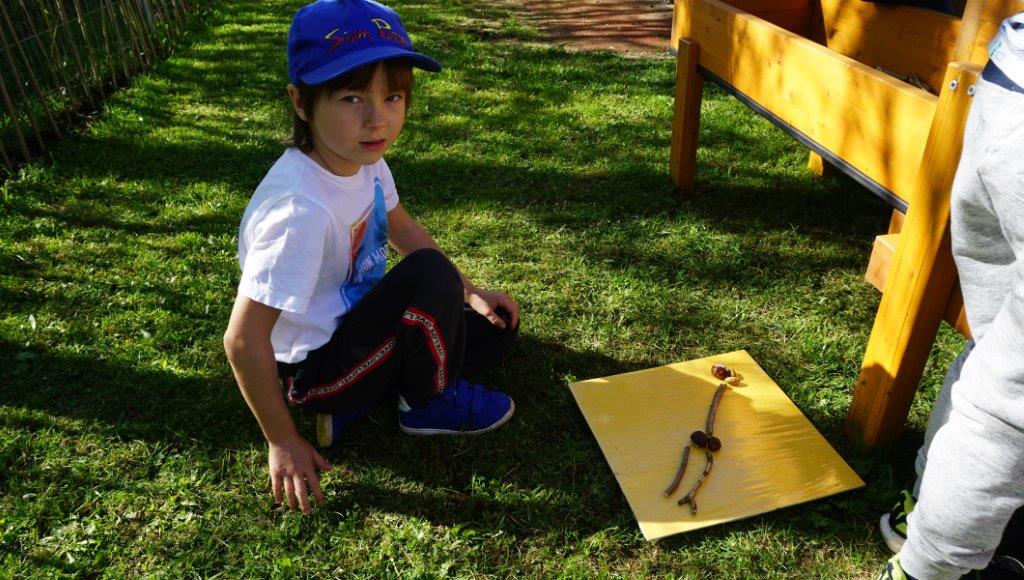
When the math was done, the children cleaned up their place and hid the geometrical shapes for the next group of children to find.